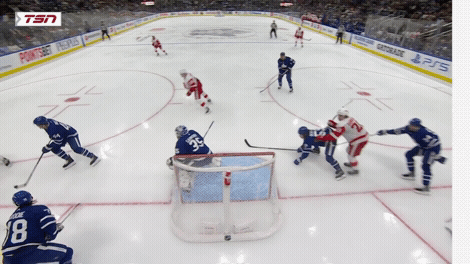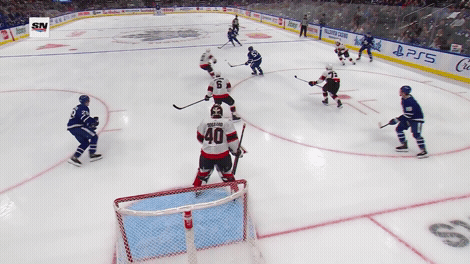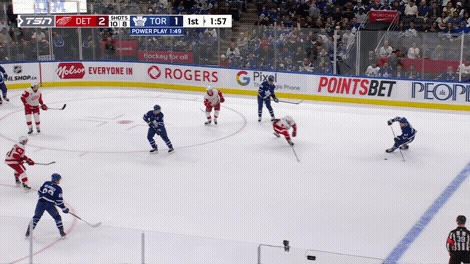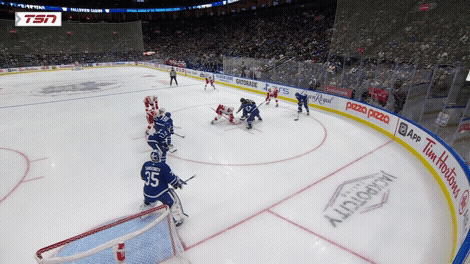By the time our American friends had mashed the potatoes for Thanksgiving in 2022, the Toronto Maple Leafs knew they’d be playing the Tampa Bay Lightning in the first round of the 2023 playoffs. The lead-up to that series was long and arduous.
It was possible things could change, but teams visibly worse than them had tumbled down the standings, and the Bruins were off to a record-setting points pace. With that, the Leafs began to experiment with just about every conceivable line-up look, to the point our producer on Real Kyper and Bourne, Sam McKee, started calling Sheldon Keefe “Tinkerbell,” as even when things were good he was tinkering with the lineup. They wanted to know what options they had regardless of scenario.
Despite that constant flux, one thing stayed the same, and that was the basics and structure of how the team played. Like many teams in the league, in the defensive zone the Leafs played a zone defence, similar to the type the Boston Bruins used so well over the past decade.
But, I’m not sure the Leafs will do that again this season.
Below are five stylistic things with the Leafs that I’ll have an eye on this season.
First would be what I was discussing above, the…
D-zone coverage
Last year, the Leafs played zone coverage in their own end, and in pre-season, it looks like they’re trying something of a hybrid coverage.
The difference is small but significant.
In the offensive zone, teams today almost all employ a high forward, running three people up around the blueline, both because there’s space there, and it forces defences to make tough coverage choices. In a zone system, let’s say a D-man is checking a puck-carrying forward who’s skating the puck up the wall from the corner towards his own D-man. In the past, the Leafs would hand the coverage of that forward off from the D-man to their winger, the D-man would fold back underneath, and their center would come up to handle the high numbers as the defence retreated back to handle things low. That decision by the defence, to hand off the opposing forward to his winger, would normally take place around the hashmarks.
I’ve seen a few examples where the Leafs’ defence is coming way out and staying man-on-man as the puck comes high. So in a zone, Ryan Reaves would take over coverage of this puck carrier in this below clip. In man-on-man, he’d stay fronting his D, Shayne Gostisbehere, and Rielly would simply stick with his man, which he seems intent on doing.
It seems like the two get their wires crossed, but Rielly not talking to Reaves here (visible from a different angle) makes me think he believes he’s still on the puck carrier, and there’s nothing to communicate:
If the Leafs go man-on-man high in the D-zone, it will be adopting the style that saw Tampa Bay win a couple Cups. It’s not super uncommon around the league. (Ironically, I’m hearing Tampa Bay has shifted into a zone system for the season ahead.)
If the Leafs do go man-on-man high, that will leave them with centres low in the zone more often, which may be part of the reason they’re OK trying this. It’s a system that causes less confusion (less switching), so if you trust your centres low, you might as well try it. And, Auston Matthews gets Selke votes every year, David Kampf is a D-zone stud, and even John Tavares at least understands where to be positionally well in the D-zone. It could be a problem for guys like William Nylander and Fraser Minten, but not every system can suit every player. The switch could result in fewer breakdowns, provided their centres are on their toes.
PP structure
I really liked this note on Andrew Brewer’s Twitter feed about an adjustment power plays seem to be making. Here’s a goal Tampa Bay scored in pre-season that highlights what’s happening:
Essentially, penalty kills have become so wary of flank shooters (since everyone runs a 1-3-1 power play now), so they flex their defence out to them, while trusting the weak-side centre to cover net-front while they get out and pressure. They want to take away those one-timers from guys like David Pastrnak, Steven Stamkos, Patrik Laine and Alex Ovechkin.
That leaves room underneath for low plays, which the Leafs have scored on this season against a D-man caught between flexing out to the wing and not. The net-front guy just has to pop to the goal line.
You can see it even when they don’t score. They’ll have Marner as the “net front” guy (it’s not the war zone it used to be), knowing they want Tavares to still be the trigger there, but it allows Marner to use his playmaking abilities. Look at him getting low and looking to make plays to the inside against Detroit:
As I’ve noted a couple times this pre-season, 85 per cent of PP goals come from below the hashmarks. Look for more low play from the Leafs power play this season, even with John Klingberg at the top (who should serve to better pull people away from the net).
Penalty kill strategy
I’m curious if the Leafs will deploy a score-dependant PK. I think it’s great Auston Matthews is getting some run there, as he’s always near the top of the league in takeaways and blocked shots. He has a great sense for where the puck is going next and an excellent stick.
Still, you’d rather he not get hit with more pucks.
I’m curious if the Leafs will use him in that role when they’re in a game that’s within a goal either way, but not use him there when they’re up two, maybe?
One other quick PK thing: I’m curious if, instead of sending the centre out on a lost draw on the PK, the Leafs would consider sending the winger in the middle, and folding the centre under? It would cut off the weak side and keep the puck on one side of the ice.
It’s about 50/50 around the NHL in terms of strategy here, and those who send the centre out like the Leafs leave themselves exposed to this option off clean lost draws. (Jake McCabe can flex out harder here but in the end they need a save from Ilya Samsonov.)
OK, two more abstract ones now:
Possession stubbornness
It feels like the Leafs have seen that in the post-season, sometimes you just have to go north with the puck, and that hanging on to it at all costs just isn’t viable (unless your name is William Nylander). The opposing teams muck up the neutral zones so much, and playoff teams are so good when the hockey gets serious, sometimes you just have to punt it a zone or two and win it back.
In the regular season, that’s not as necessary. But as we learned from the Toronto Blue Jays recently, regular season habits can show up in the post-season at bad times, so I’m curious if they’ll opt for a more north-south game at times this season.
And finally,
AHL call-ups
I’d like to see the Leafs call guys up liberally this season once things slow down in late November and beyond. You just get so much juice from young motivated players at the times of year the regulars may take their foot off the gas pedal, as Pontus Holmberg showed them last year.
So can they rest John Tavares for Homberg at times? Can Bobby McMann be a regular guy to come up and provide absolute max effort some random Tuesdays in Columbus? Can Nick Robertson get his share of NHL games even if he doesn’t stick with the team out of camp?
They’ll have some nice players in the AHL this season, at forward in particular. I’m hoping they use them liberally this season, and don’t just wait for injuries to do so.







No comments:
Post a Comment